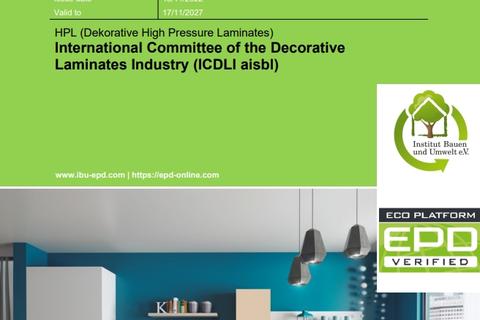New environmental product declaration for HPL and HPL-Compact

Environmental
Product Declarations (EPDs) provide quantitative, verified and
objective information on the environmental impact of a product based on
clearly defined parameters. For the high-performance materials HPL and
HPL-Compact, EPDs based on life cycle assessments have already been
available for several years, which consider the complete life cycle (raw
material extraction, production, transport, installation/use,
recycling). Now an update of the declaration for the next five years has
been published, which once again confirms the low environmental impact
of HPL and HPL-Compact.
Especially in the building sector, environmental product declarations are used by architects, planners, engineers and builders to prove and guarantee the most sustainable construction possible in tenders. The new environmental declaration for HPL and HPL-Compact maps the environmental impact of the surfaces over their entire life cycle and also describes their functional and technical properties.
Protection of environment and climate is key
In
the new EPD, several life cycle assessment criteria, for example on
production and transport and for more transparency, were split up. Once
again, the low ecological footprint of the
products became apparent,
for example in the area of Global Warming Potential: the production of
one square metre of HPL emits only 1.26 kg of CO2 equivalent.
Generally speaking, the greatest environmental advantage of HPL is its long service life. The material is easy to clean, hard-wearing and resistant and scores with a long service life. During the use phase, 0.29 kg of biogenic carbon corresponding to 1.06 kg of CO2 equivalents are stored in the HPL. The ICDLI is currently working together with the Fraunhof Institute/WKI on a European end-of-life study on HPL, which will provide information on how the boards are recycled at the end of the use phase.
Based on international standards
The verified environmental declaration on HPL is based on the international standards ISO 14025 and EN 15804 and is published by the Institut Bauen und Umwelt e.V. (Institute for Building and Environment). It is valid for five years and is publicly accessible. It can be used to compare and select different building components, construction methods and options according to ecological criteria already in the design phase.
Objective, neutral, well-founded
The comprehensive LCA data and information contained in EPDs are compactly summarised in a uniform format on a few pages. The EPD of the ICDLI is a European average declaration in which data from HPL manufacturers from all over Europe were collected and evaluated. Since 2012, consistently representative information on the average environmental profile for HPL and HPL-Compact has been available.
The ICDLI offers an exclusive report in English on its website with explanations on the EPDs: for example, on the value of these sustainability reports and a summary of their most important statements. Read more: https://www.icdli.com/tech-centre/.
Press release as pdf document
About ICDLI
The ICDLI is the international representation of the European laminates manufacturers. The association aims at creating a strong and successful European community of the manufacturers as well as at the continuation of the success story of HPL.
Press contact
ICDLI – International Committee of the Decorative Laminates Industry aisbl
Dr. Patrick Kohlas
Phone +49 69 40 89 555 46
E-Mail patrick.kohlas@pro-kunststoff.de
Internet www.icdli.com
